0 / 32
0 / 32
History of Muay Thai: From Ancient Warriors to Modern Sport
October 11, 2024
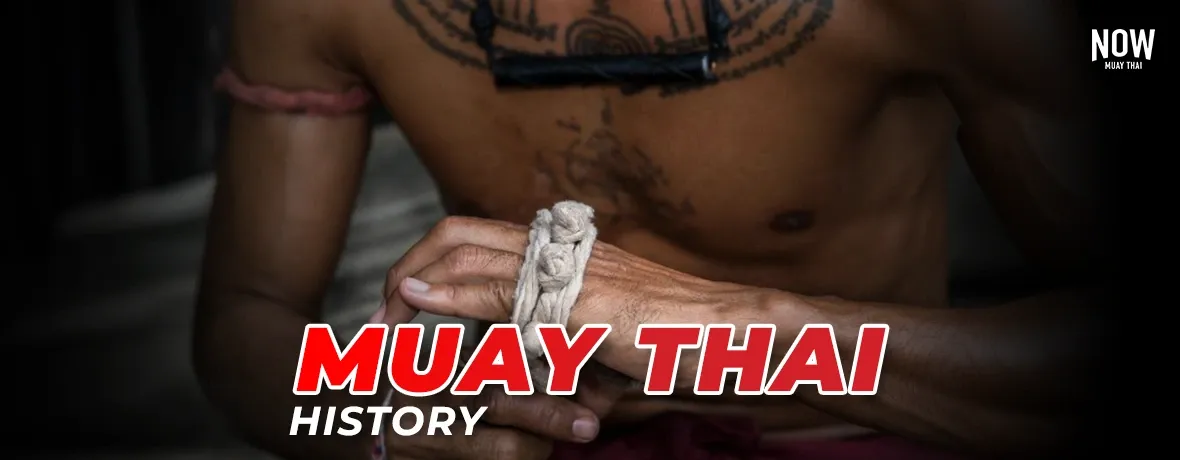
Muay Thai, often called the "Art of Eight Limbs," is a martial discipline with deep historical roots in Thailand. Initially crafted for warfare, it evolved from Muay Boran, an ancient system of unarmed combat. This fighting style enabled warriors to utilize fists, feet, elbows, and knees as weapons. In some variations, the head and hips were included, referring to the art as Nawa-Arwut (nine weapons, including the head) or Tosa-Arwut (ten weapons, including the buttocks), showcasing its adaptability.
Muay Thai’s history is intimately linked to the rise of the Thai nation. It served not only as a battlefield tool but also as a method for developing strength and courage among soldiers. Over time, as it transitioned from military application to a regulated sport, the introduction of boxing gloves helped protect fighters and formalize matches. Despite these changes, Muay Thai has retained its essence as a formidable form of both offense and defense.
The development of Muay Thai spans several important periods—Sukhothai, Ayutthaya, Thonburi, Rattanakosin, and its modern form—showcasing its progression from an essential combat skill to Thailand’s national sport. Throughout its evolution, Muay Thai has played a pivotal role in shaping Thai culture, identity, and national pride.
Sukhothai Era: The Foundations of Muay Thai (1781-1918 AD)
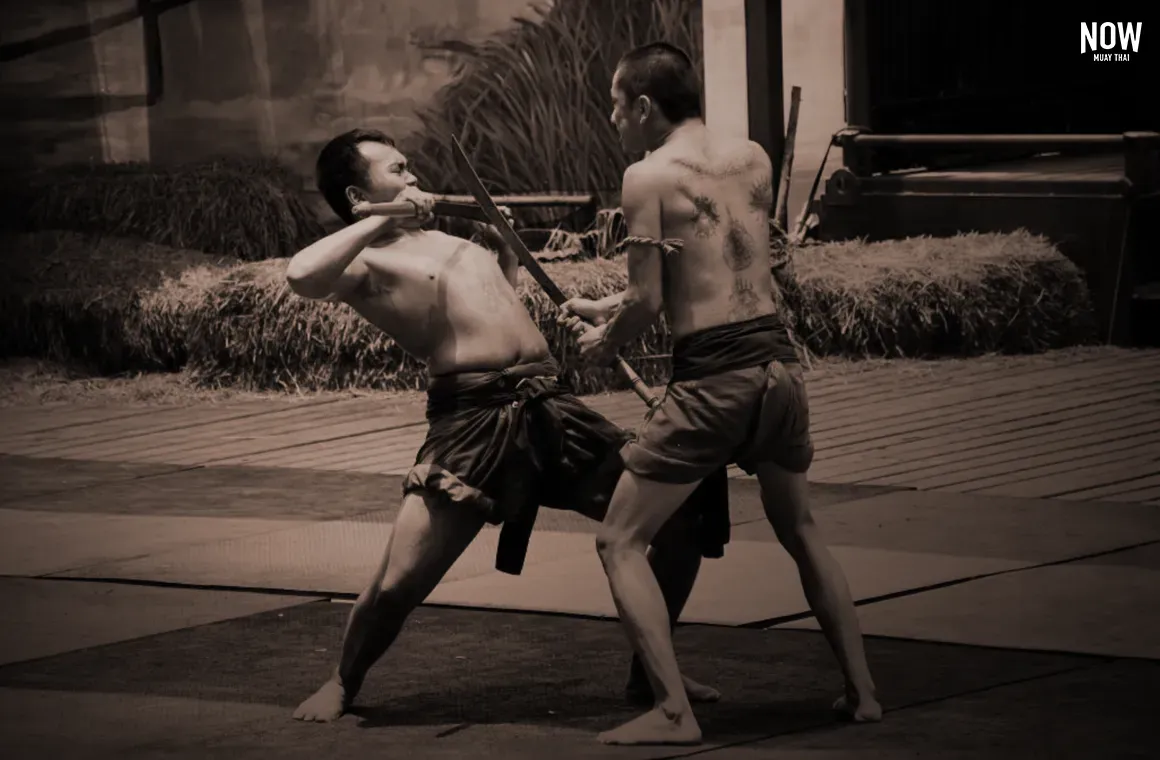 Two warriors engaged in a fierce battle, showcasing traditional Muay Boran techniques while wielding swords. Their fluid movements combine martial arts skills and weapon combat, representing the ancient fighting style of Thailand's warriors.
Two warriors engaged in a fierce battle, showcasing traditional Muay Boran techniques while wielding swords. Their fluid movements combine martial arts skills and weapon combat, representing the ancient fighting style of Thailand's warriors.
During the Sukhothai era, Muay Thai was considered a high-level martial art and part of the royal curriculum. Kings were trained in Muay Thai to enhance their physical strength and combat skills. Historical records mention King Sri Intradit sending his son, Prince Ruang, to train in Muay Thai at the Khao Samorkorn martial school, known as the origin of Muay Lopburi. Additionally, King Ramkhamhaeng authored the Treatise of War, which included Muay Thai alongside weapons training with swords, spears, and bows. This era laid the foundation for Muay Thai as a core part of military and royal education.
Here’s the revised version of your content, shortened by about 20% and incorporating the story of Phra Chao Suea (the Tiger King):
Ayutthaya Era: The Golden Age of Muay Boran
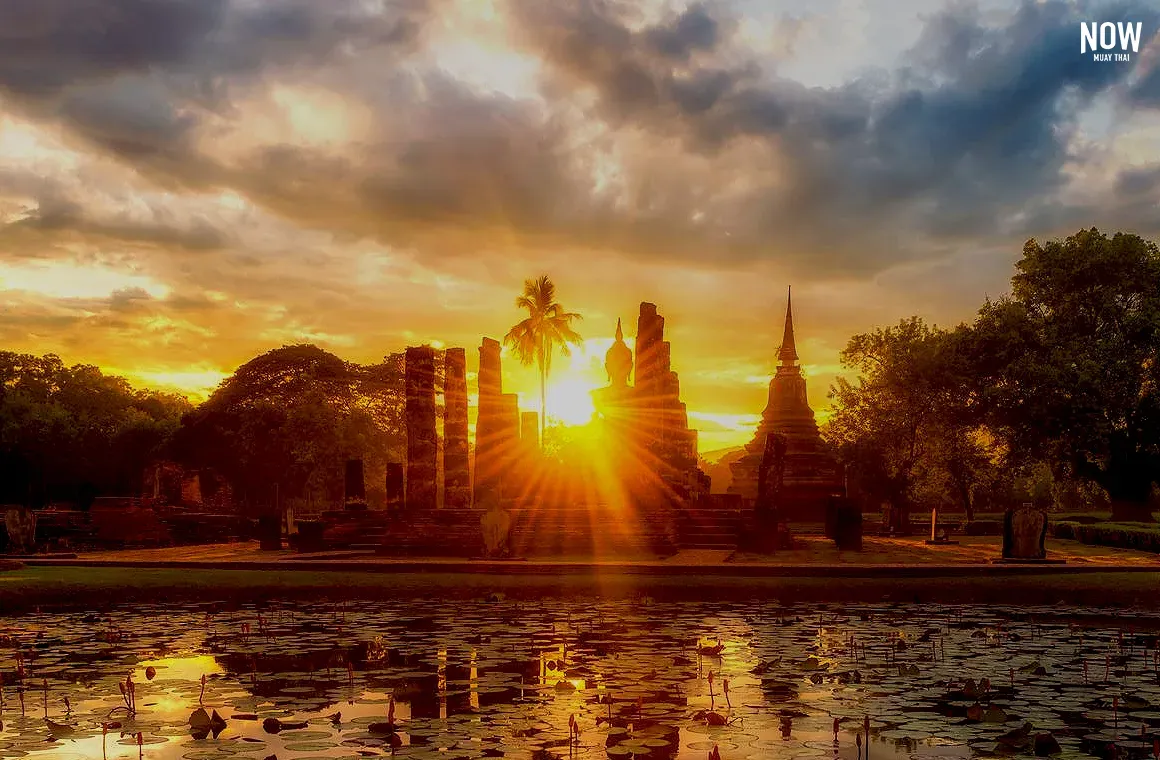 A majestic Big Buddha statue illuminated by the soft glow of sunrise at a temple in Ayutthaya, symbolizing the golden era of Muay Boran. The serene scene reflects the historical significance of Ayutthaya as the birthplace of Muay Boran, blending Thailand's spiritual and martial heritage.
A majestic Big Buddha statue illuminated by the soft glow of sunrise at a temple in Ayutthaya, symbolizing the golden era of Muay Boran. The serene scene reflects the historical significance of Ayutthaya as the birthplace of Muay Boran, blending Thailand's spiritual and martial heritage.
The Ayutthaya era (1350-1767 AD) was a defining period for Muay Boran, as the kingdom was often at war with its neighbors. During this time, Muay Boran evolved beyond a combat skill to become an essential part of military training and a widely celebrated cultural phenomenon.
 The Monument of King Naresuan the Great at Naresuan University, depicting the historic moment when he poured sacred water, symbolizing Ayutthaya's declaration of independence from the Burmese Taungoo Empire. The statue stands as a tribute to King Naresuan’s leadership and his monumental role in securing Thailand’s freedom
The Monument of King Naresuan the Great at Naresuan University, depicting the historic moment when he poured sacred water, symbolizing Ayutthaya's declaration of independence from the Burmese Taungoo Empire. The statue stands as a tribute to King Naresuan’s leadership and his monumental role in securing Thailand’s freedom
credit: Naresuan University
King Naresuan the Great (reign 1590–1605),
a strong advocate of Muay Boran, ensured his soldiers were well-trained in both armed and unarmed combat. He believed that warriors needed to be proficient in hand-to-hand combat as well as using weapons like swords and spears, which became central to the kingdom's defense strategy.
Muay Boran also flourished outside military circles, gaining popularity as a form of entertainment. Matches were often held at religious festivals and royal events, where fighters competed publicly. These contests not only displayed strength and skill but also helped identify talented fighters for military recruitment.
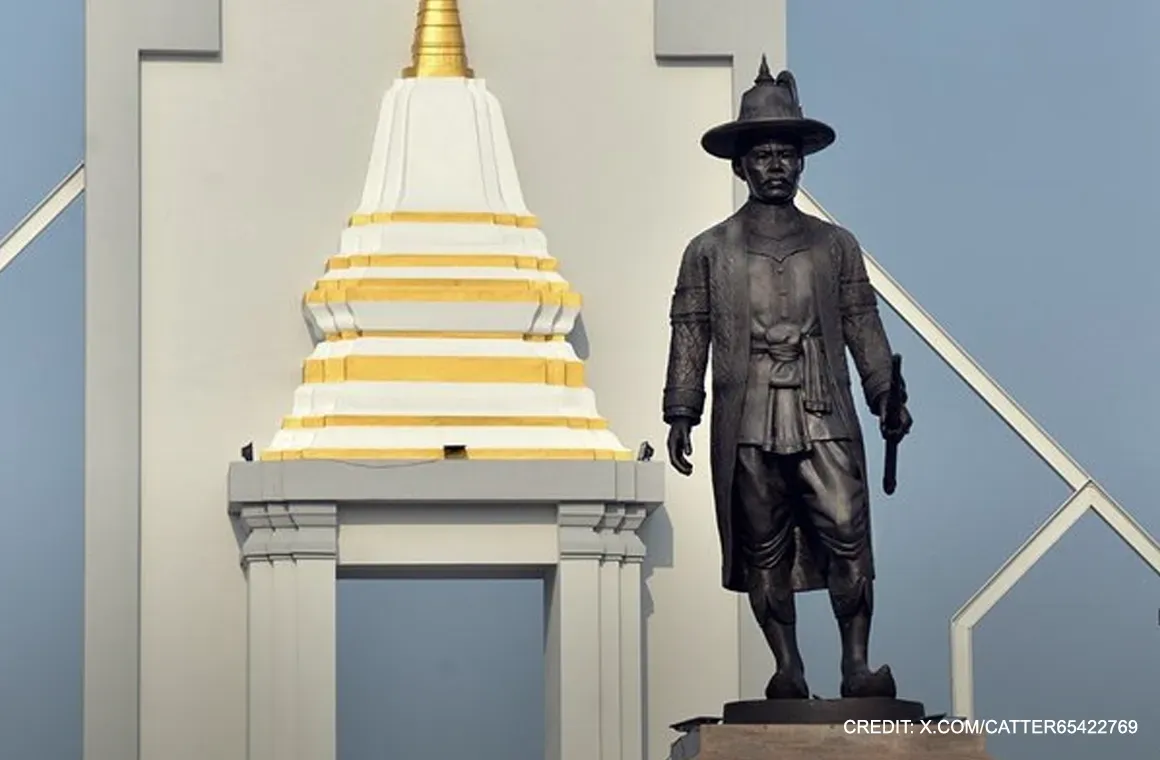 The monument of Phra Chao Suea (the Tiger King), standing tall as a tribute to the legendary Muay Thai master and king. Known for his exceptional fighting skills, the statue symbolizes his contributions to the development of Muay Thai.
The monument of Phra Chao Suea (the Tiger King), standing tall as a tribute to the legendary Muay Thai master and king. Known for his exceptional fighting skills, the statue symbolizes his contributions to the development of Muay Thai.
credit: Catter65422769 - X(twitter)
One of the most famous figures from this era is Phra Chao Suea (the Tiger King). Known for his exceptional fighting abilities, he often disguised himself as a commoner to participate in local boxing matches, demonstrating his mastery of Muay Boran. His contributions to the art are significant, as historical records from the reign of King Rama V reveal that Phra Chao Suea developed his own set of signature moves, known as "Tamra Mae Mai Muay Thai Tamrab Phra Chao Suea" (Muay Thai of the Tiger King). This manual is the oldest recorded documentation of Muay Thai techniques, highlighting his lasting influence on the sport.
Muay Thai Day is celebrated annually on February 6, marking the day Phra Chao Suea ascended to the throne, recognizing his contributions to Muay Thai.
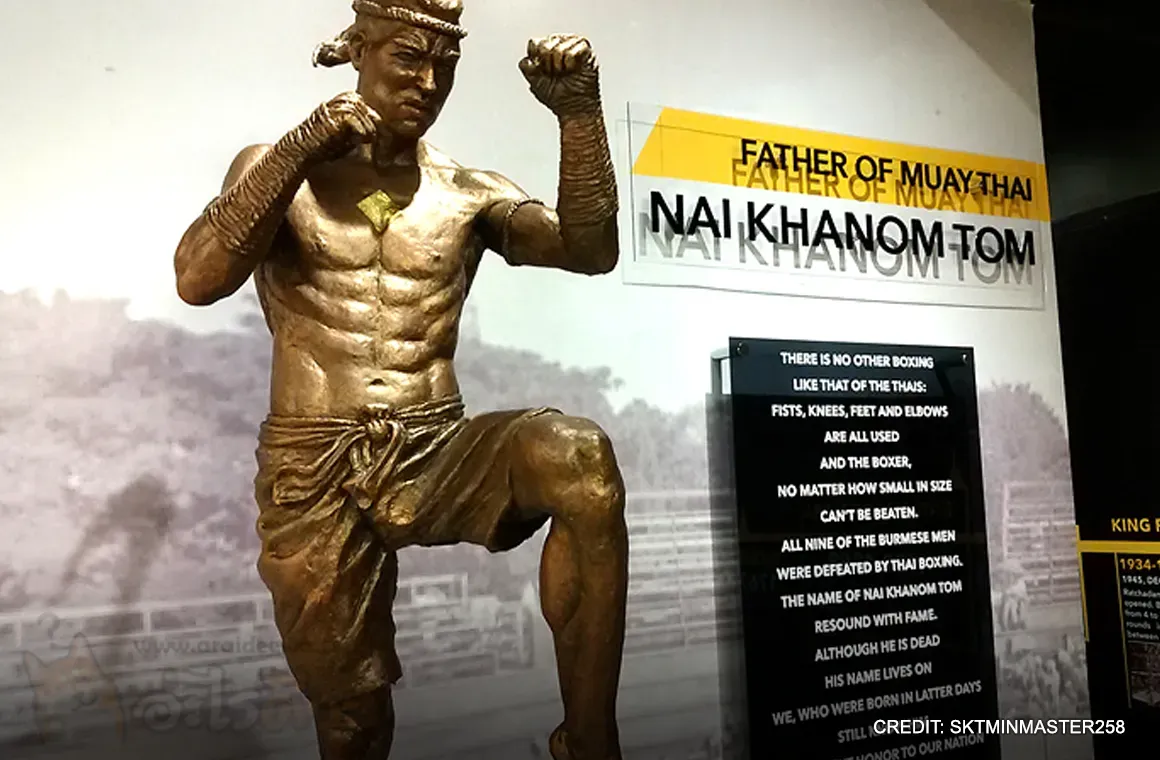 A statue of Nai Khanom Tom, the legendary Muay Thai fighter, revered as the "Father of Muay Thai." The image captures him in a traditional fighting stance, symbolizing his historic victory over Burmese fighters and his enduring legacy in Thai martial arts.
A statue of Nai Khanom Tom, the legendary Muay Thai fighter, revered as the "Father of Muay Thai." The image captures him in a traditional fighting stance, symbolizing his historic victory over Burmese fighters and his enduring legacy in Thai martial arts.
credit: sktminmaster258
Another legendary figure from this period is Nai Khanom Tom, who became a symbol of Muay Boran's effectiveness. After the fall of Ayutthaya in 1767, he was captured by the Burmese and later participated in a tournament organized by King Mangra in 1774. Using Muay Boran techniques, he famously defeated nine or ten Burmese fighters in succession, cementing his place in history. Nai Khanom Tom is often revered as the “Father of Muay Thai” for his contributions to the sport’s legacy.
Thonburi Era: The Resurgence of Muay Boran
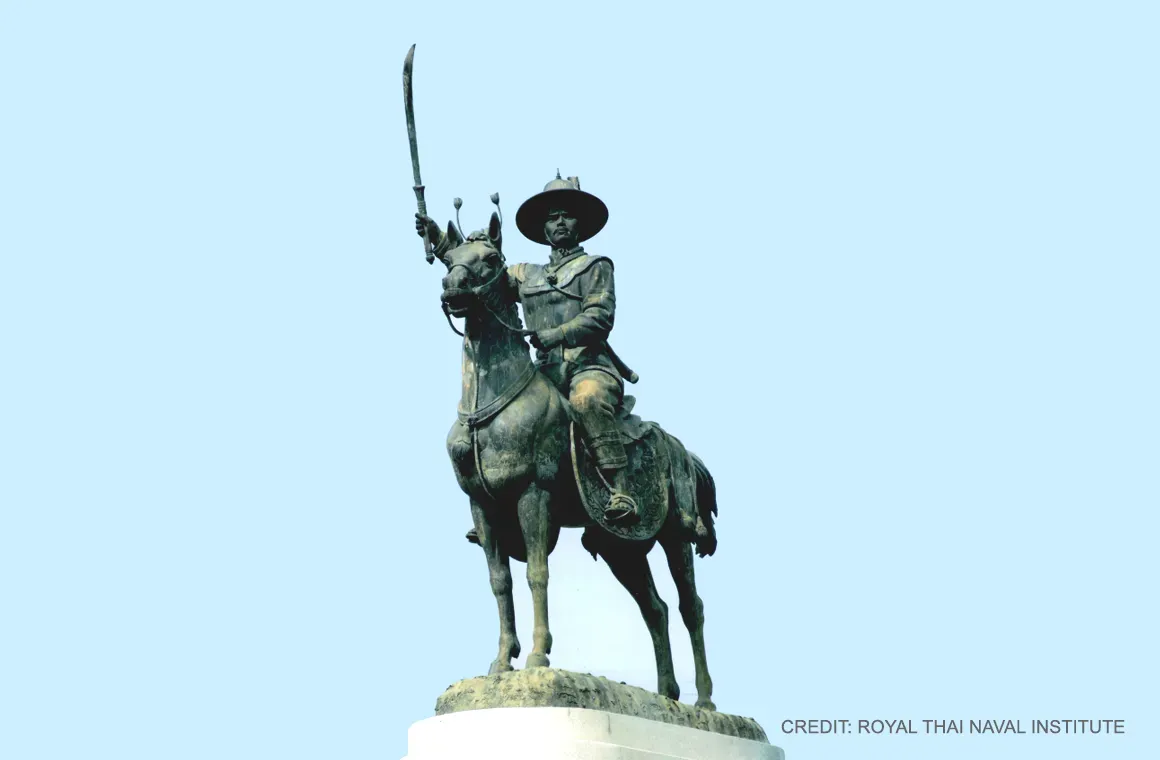 The monument of King Taksin the Great, depicted on horseback in a powerful pose, symbolizing his leadership and military prowess. The statue honors his role in unifying Thailand and restoring independence after the fall of Ayutthaya, representing a pivotal moment in the nation's history.
The monument of King Taksin the Great, depicted on horseback in a powerful pose, symbolizing his leadership and military prowess. The statue honors his role in unifying Thailand and restoring independence after the fall of Ayutthaya, representing a pivotal moment in the nation's history.
credit: Royal Thai Naval Institute
During the 14-year reign of the Thonburi Kingdom (1767–1782 AD), Muay Boran played a critical role in military training and warfare. After King Taksin the Great restored Thailand’s independence, the kingdom needed to rebuild its military strength to defend against future threats. In this era, Muay Boran was used primarily to prepare soldiers for battle rather than for sport.
Muay Kard Chuek—a form of Muay Boran where fighters wrapped their hands with ropes—was a popular way to settle disputes and test fighters’ skills. These matches were often held between fighters from different regions or schools, without formal rules or a scoring system. Competitors fought until one conceded, often in open areas like temple grounds. Fighters traditionally wore Mongkol headbands and tied Pra Jiad armbands for protection and good luck, reflecting the deep spiritual and cultural aspects of Muay Boran.
A legendary figure from this era is Phraya Phichai Dap Hak, a respected general and master of Muay Boran. During a fierce battle defending the city of Phichai, Phraya Phichai fought using two swords. When one sword broke in the heat of battle, he continued fighting with a single sword, using his Muay Boran skills to lead his troops to victory. His bravery earned him the title "Dap Hak" (Broken Sword), and he became a symbol of the effectiveness of Muay Boran in combat, as well as a figure of national pride and resilience.
Muay Thai in the Rattanakosin Era (1782 – Present)
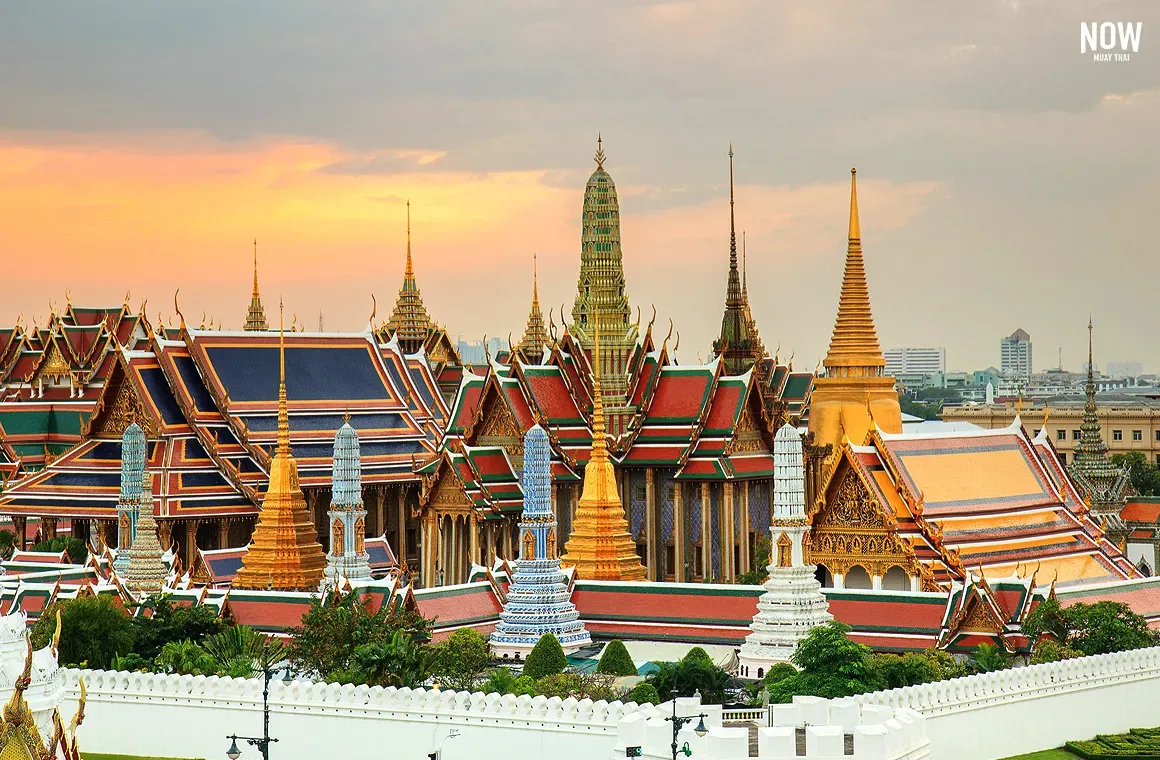 A stunning view of the Grand Palace and Wat Phra Kaew, illuminated in golden light, symbolizing the cultural and historical significance of the golden era of Muay Thai.
A stunning view of the Grand Palace and Wat Phra Kaew, illuminated in golden light, symbolizing the cultural and historical significance of the golden era of Muay Thai.
The Rattanakosin era, beginning in 1782, marks the transformation of Muay Thai from an essential military skill into Thailand’s national sport. King Rama I was a significant supporter of Muay Thai, having trained in the art from a young age. One famous event during his reign occurred in 1788, when two French brothers, one an accomplished boxer, arrived in Bangkok. The younger brother challenged the locals to a boxing match. After consulting with his brother, Krom Phra Ratchawangbowon, who oversaw the royal boxing department, King Rama I arranged for Muen Phlan, a skilled Thai fighter, to represent Thailand. The fight took place behind Wat Phra Kaew in a square ring made with four posts and a single rope. The Thai fighter's superior technique wore down the Frenchman, leading to a chaotic conclusion when the older brother interrupted the match, resulting in a scuffle between the two sides.
In the reign of King Rama II (1809–1824), Muay Thai continued to thrive. The king, having trained in Muay Thai at Wat Bang Wa Yai or Wat Rakhang Kositaram in currently named under Somdej Phra Wannarat, further refined his skills during his youth. During this period, he built a royal boxing ring at Wang Lang, and it was during his reign that the term "Muay Thai" officially replaced the older term "Ram Muay."
Under King Rama III (1824–1851), Muay Thai was popularized even further. During this period, Thao Suranari, a famous female fighter, led the defense of Korat using her knowledge of Muay Thai and swordsmanship, contributing to the defeat of the invading forces from Vientiane led by King Anouvong.
During King Rama IV's reign (1851–1868), despite growing Western influence, Muay Thai retained its position as Thailand's national sport. King Mongkut himself, as a child, participated in Muay Thai demonstrations during religious festivals, showcasing his prowess alongside the art of swordsmanship.
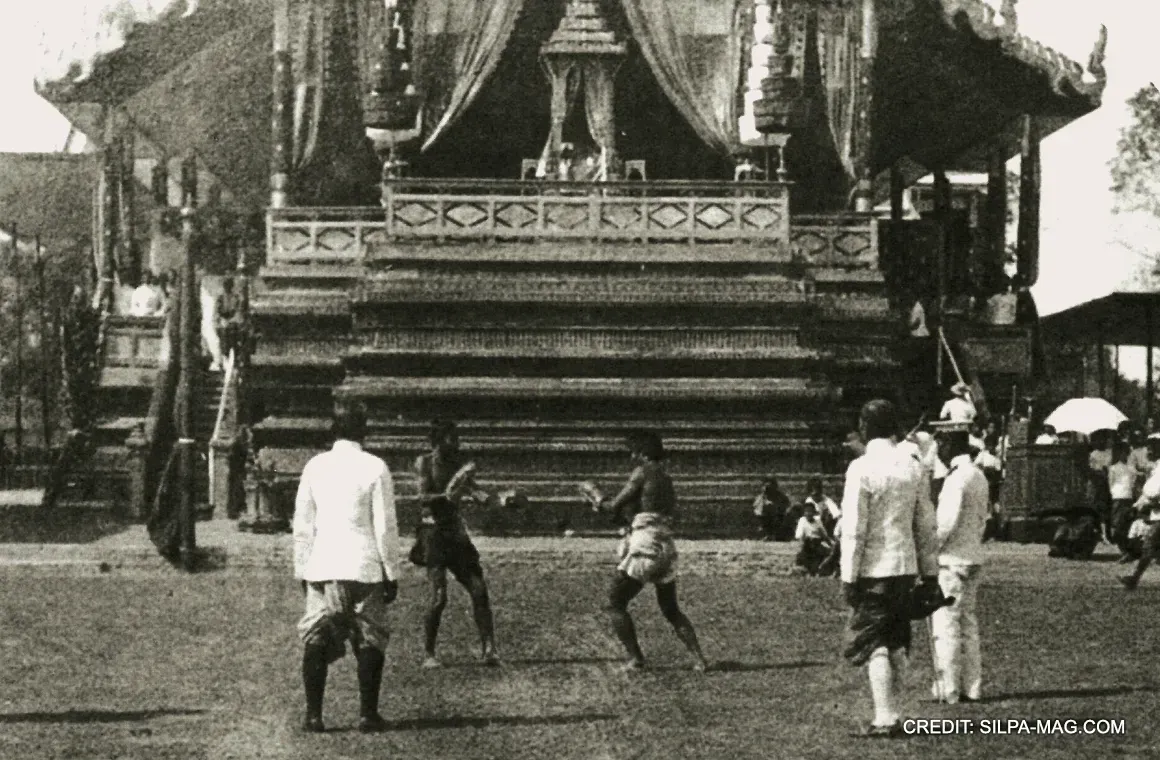 An image of King Rama V, known for his great admiration of Muay Thai, watching a traditional Thai boxing match from his royal seat.
An image of King Rama V, known for his great admiration of Muay Thai, watching a traditional Thai boxing match from his royal seat.
credit: silpa-mag.com
The golden age of Muay Thai emerged during the reign of King Rama V (1868–1910). He actively promoted Muay Thai as a key part of Thai culture. The king ordered the royal courts to select the best fighters from across the country to compete in front of the royal family. Competitions were held regularly, and fighters who excelled were selected to serve in the Royal Guard. Muay Thai became part of the curriculum in military academies, and in 1890, King Rama V established Muay Luang, or "Royal Muay Thai Schools," in several provinces to ensure the art's survival and growth, serving the purpose of training, organizing competitions, and overseeing Muay Thai events across the country.
Under King Rama VI (1910–1925), Muay Thai began to take on a more organized structure. During this time, permanent rings were built, and the first major stadium was constructed at Suan Kulap College*. Muay Thai's international exposure began during World War I, when Thai soldiers demonstrated Muay Thai to European soldiers and civilians, marking its first official appearance in Europe.
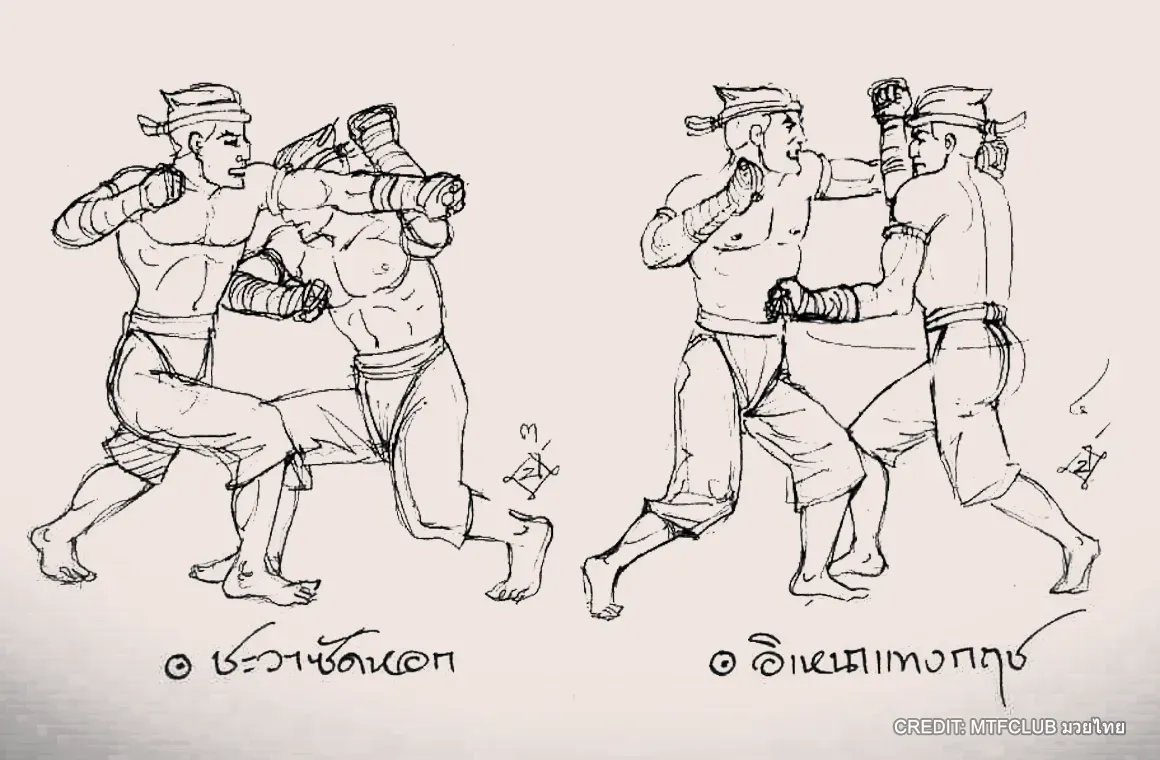 An image of a page from the Tamra Mae Mai Muay Thai Tamrab Phra Chao Suea, showcasing ancient Muay Thai techniques. The document highlights the traditional fighting methods developed during his reign.
An image of a page from the Tamra Mae Mai Muay Thai Tamrab Phra Chao Suea, showcasing ancient Muay Thai techniques. The document highlights the traditional fighting methods developed during his reign.
credit: MTFclub มวยไทย - facebook
The sport was further modernized during the reign of King Rama VII (1925–1935), when Phra Chao Suea’s legendary techniques were codified. Modern boxing gloves replaced traditional Kard Chuek, and standardized weight divisions were introduced, enhancing safety and fairness. The construction of stadiums such as the Lak Muang Stadium in Tha Chang also laid the groundwork for the modern sport we see today. Muay Thai became more regulated, with three judges, and fights were judged by points rather than by submission or knockout.
During the reign of King Rama VIII (1935–1946), the spread of Muay Thai continued despite the disruption of World War II. Makeshift rings in cinemas and other indoor spaces became the norm, with large public gatherings avoided due to the conflict.
Under King Rama IX (1946–2016), Muay Thai grew into a global phenomenon. The iconic Rajadamnern Stadium, which opened in 1945, and Lumpinee Stadium in 1956, became the epicenters of Muay Thai. Weekly fights broadcast across the nation helped popularize the sport further. Modern rules, such as five 3-minute rounds and the use of red and blue corners, were standardized. This period solidified Muay Thai as both a professional sport and a cultural treasure, practiced and admired worldwide.
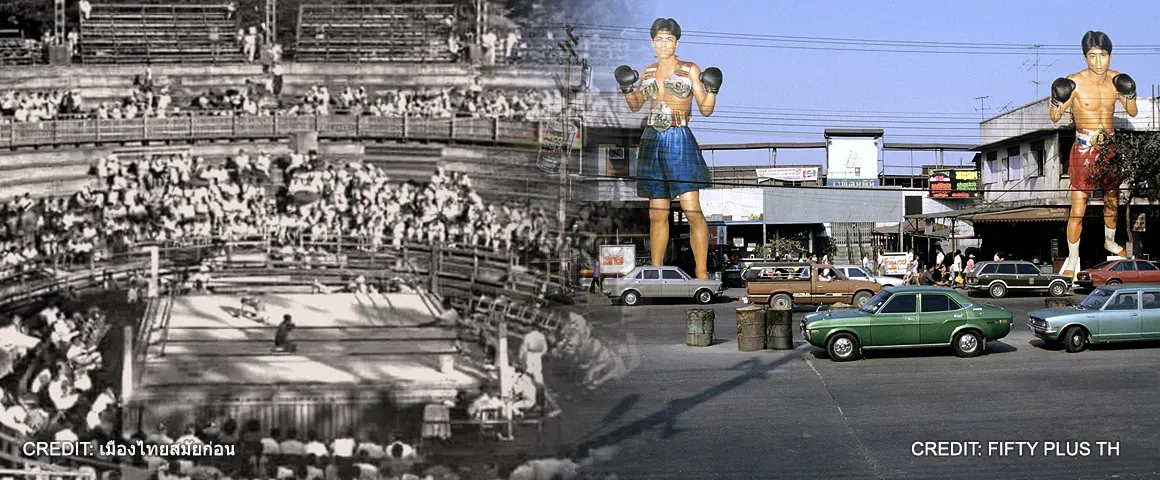 An image featuring historical photos of Rajadamnern Stadium and Lumpinee Stadium, two iconic venues in the history of Muay Thai.
An image featuring historical photos of Rajadamnern Stadium and Lumpinee Stadium, two iconic venues in the history of Muay Thai.
credit: เมืองไทยสมัยก่อน - facebook
credit: Fifty Plus - facebook
Modern Era: Regulating and Promoting Muay Thai
In the modern era, Muay Thai competitions are regularly held at Rajadamnern and Lumpinee Stadiums, as well as in many permanent and temporary boxing venues across Bangkok and other provinces. These stadiums remain central to the sport, hosting regular professional matches, including championship bouts.
In 1999, the Thai government enacted the Boxing Sports Act, which created the Board of Boxing Sport under the Sports Authority of Thailand. This act provides legal authority to regulate, promote, and protect Muay Thai as a professional sport. The Board of Boxing Sport is responsible for overseeing the conduct of matches, ensuring fighter safety, and preserving the integrity of Muay Thai in line with national and international regulations. This legislation marked a significant step toward professionalizing Muay Thai, ensuring its continued growth and its protection as a key part of Thailand's cultural heritage.
Experience Authentic Muay Thai and Thai Culture
If you’re passionate about Muay Thai or just curious to give it a try, there’s no better place than Thailand to experience it in its most authentic form. Training here goes beyond the physical—it’s about immersing yourself in Thai culture, learning from the best, and connecting with the spirit of Muay Thai. Whether you’re a beginner or an experienced fighter, Thailand’s gyms offer everything from city-based training to peaceful beachside camps, perfect for all levels. Ready to start your journey? Head over to Nowmuaythai.com to find the perfect Muay Thai gym for you and dive into an unforgettable adventure!
Learn more about Muay Thai
Back








